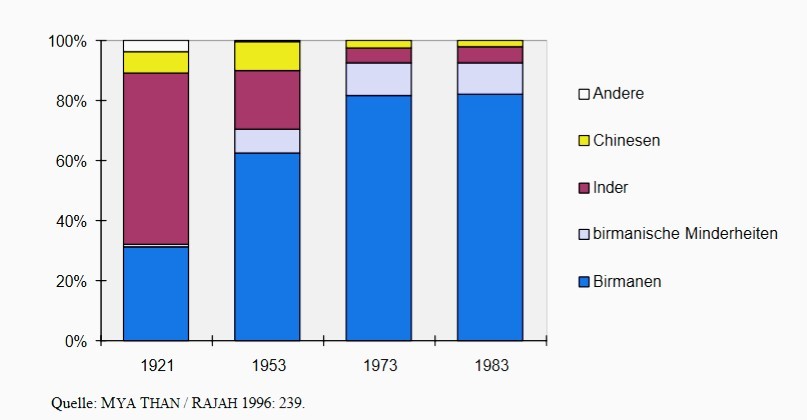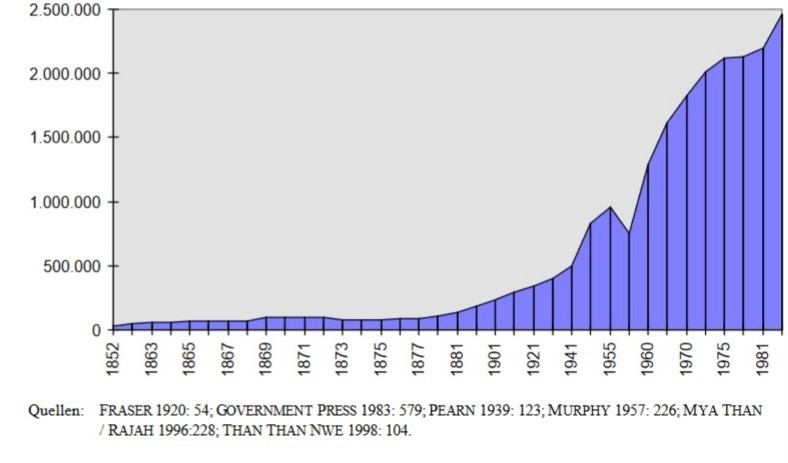Rangoon housing after independence

Yangon is growing at a breathtaking pace. It won’t be long before it’ll join the league of megacities, i. e. cities with more than 10 million inhabitants (UN definition). Before WW II Rangoon was home to around 300.000 people and a fairly cosmopolitan city. Native Burmans made up one third of the population, the majority had Indian roots and there was a sizable Chinese population. Around 3 % were ‘foreigners’ of all kinds.
During the war many people fled the city, especially Indians. Many of them didn’t return afterwards and many of those who did later changed their mind and left for good in the mid fifties (see tables).
The disturbances after independence led to a steep population increase as the countryside was not safe anymore and country folk took shelter in Rangoon. Many of them remained. The city government struggled hard to cope with the influx but nevertheless the city was full of slums that shot up at every corner. Satellite towns like Tharketa, North and South Okkalapa etc. managed to ease the burden quite a bit but until this day Yangon is an overcrowded town. Following pls. find a fascinating story from the 1950s and 60s.

Rangoon slums (by Harry Hpone Thant)
Myanmar dived into a civil war right after Independence in 1948. Fighting erupted all over the country. IDPs flocked to big towns to escape the fighting and Rangoon was no exception. Refugees flooded Rangoon. The pedestrian footpaths along the main thoroughfares like Dalhousie Road (now Maha Bandoola Road), Fraser Road (now Anawrahta Road) and bombed out vacant plots in many parts of the city became slums. That time I was around 5 years old.
One could escape the rains without need for an umbrella by walking under the roofs of these bamboo huts. Families tightly packed, unhygienic and filthy. Everything could be found here. Clothes, kitchen utensils, household goods, food stalls too. Criminal gangs flourished. I can still remember some criminal activities that happened in our street during those times. Once there was a robbery at a house not far from our home. That single storey house was occupied by two ladies, both spinsters living by themselves. Nobody suspected anything until the elder sister came rolling out, wrapped up in a mosquito net.
Another case was a robbery somewhere and one of the robbers tried to outrun the chasing mob. He ran along the back drainage space behind our row of houses. Our house was at the end and my father had stationed himself at the exit and when the robber approached he swung at him and flattened the criminal. I was watching from upstairs as my mother had locked me in as soon as she heard the commotion. For this heroic capture my Dad was awarded an Appreciation Certificate and a revolver by the Commissioner of Rangoon Police as commendation, who by the
way was his friend! I handed in this gun to the police after the death of my Dad in 1968 as I do not know how to use it, anyhow. Then in 1958 the Caretaker Government of Gen.Ne Win came into power. He appointed a new Mayor, a full colonel named Col.Tun Sein. The new Mayor pledged to clean up the city. Then demolished all the slum areas and sent these squatters to new satellite towns in the outskirts of Rangoon. Tharketa on the other side of the Pazundaung river was one. North and South Okkalapa were created. The Mayor used prisoners from Rangoon Jail to clean up the filth from the city’s roads. Back drainage spaces in downtown areas were cleaned of all the accumulated rubbish. His motto was ” Let’s Clean Up Our City With Our Sweat”.
At that time my father was Revenue Officer for Western Rangoon. He worked at Rangoon Development Trust, predecessor of National Housing Board-NHB. I do not know what it is called today. Anyway his department, the Land and Revenue Department, was given responsibility to clear away these squatters and develop the new satellite towns. He worked together with his superior officer as instructed of course.
These developments continued even after the civilian government came back to power in 1960. Prime Minister U Nu also built many Housing Board flats, in bombed out vacant plots in Rangoon. These HB flats were known as ‘Pyi Taw Thar Flats’ because they were built according to the ‘Pyi Taw Thar National Development Plans’. Pyi Taw Thar means Happy and Developed Nation. The Min Ma Naing HB flats opposite the Lanmadaw YMCA Hostel, the Pha Sa Pa La HB flats opposite the Aung San Stadium are some examples.